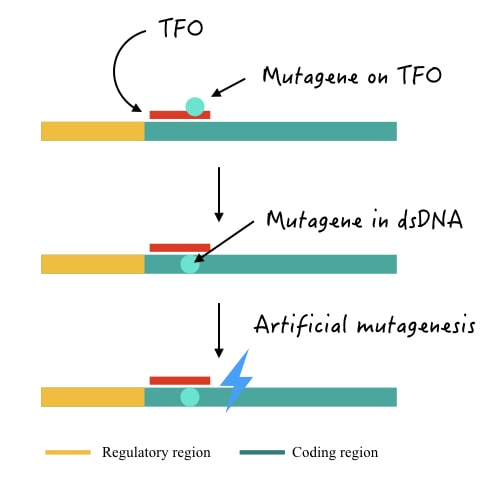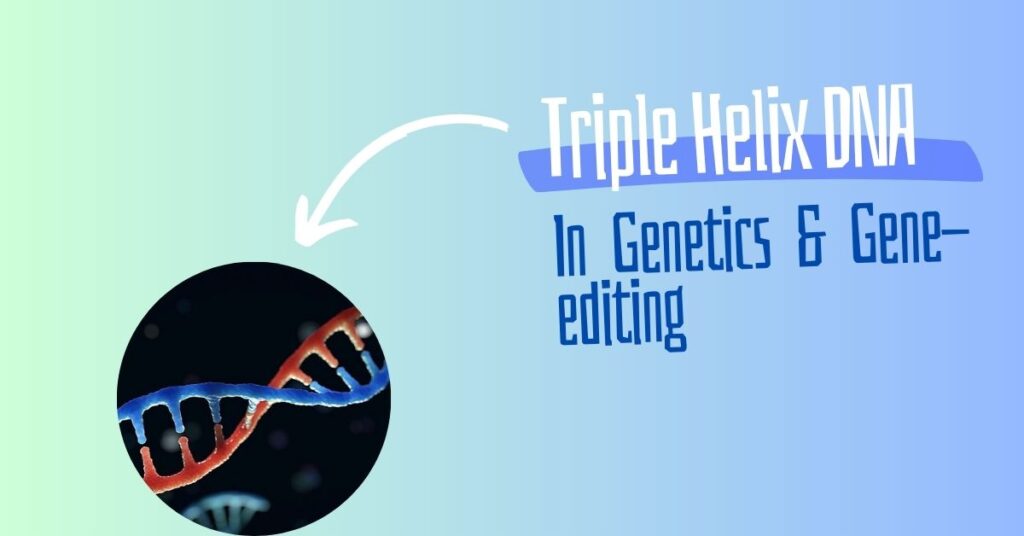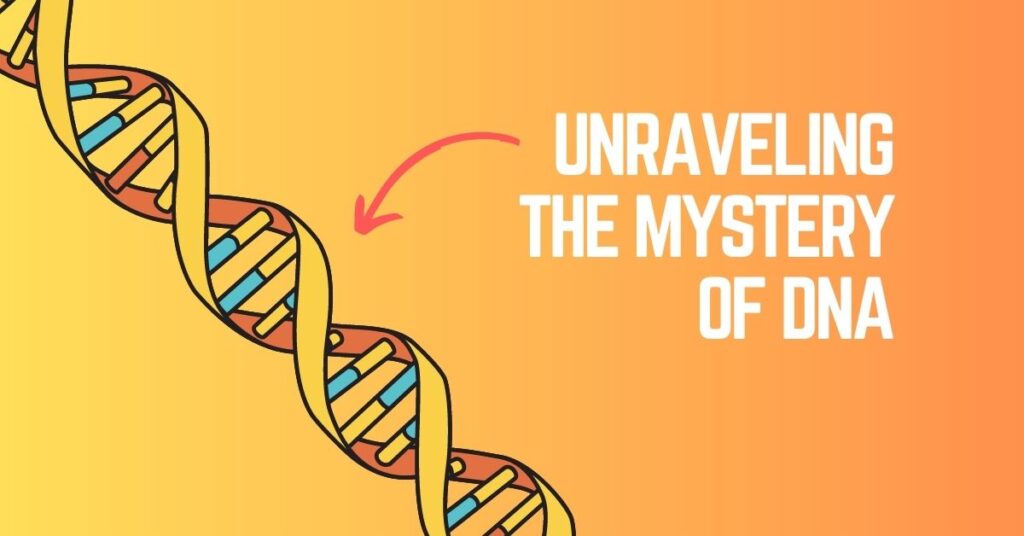“Understand how scientists can use the Triple helix DNA structure for gene editing and how it can revolutionize the field. Explore potential applications of Triple helix DNA in gene editing.”
Gene editing is a molecular genetic technique to alter the genetic material in a way that can offset the effect of the harmful gene. A gene’s activity can be triggered or silenced by artificial means. Cancer and other genetic defects can be prevented.
Currently! The state-of-the-art, highly effective and most popular technique we have is CRISPR-Cas9. It uses a guided RNA for target-specific sequence modifications, however, it can cause off-target results, oftentimes.
That off-target effect leads to unintended results which makes this futuristic approach a bit weaker. Triple helix DNA can overcome off-targeting and accurately perform gene editing. Thus it can be used as a gene-editing tool.
How is it possible? How the three strands of DNA can be used as a tool to alter DNA and what are the possibilities to use it? In this article, we will learn how scientists are using the triplex helix as a novel and potential tool in editing.
Stay tuned.
Key Topics:
Triple Helix DNA in Gene Editing:
Triple helix DNA is an atypical form of DNA that only forms when a third single strand of DNA binds with the duplex DNA by Hoogsteen base pairing. The idea was indeed developed by Linus Pauling in 1950 but experimentally demonstrated by Felsenfield and Rich in 1957.
Here, any new or the same single-strand DNA folds back and binds particularly at the DNA major groove and gives a triple helix appearance to the DNA. It doesn’t have any known biological significance.
This triplex blocks the site for enzymes and transcriptional factors and can suppress gene expression and therefore can be used as a tool for various gene therapy or editing experiments. Triplex-forming oligonucleotides- TFO, which is an artificial single DNA strand, is utilized here.
Triple helix has high sequence-specificity and the ability to compete with other transcriptional factors. These two properties enable scientists to use TFO in the regulation of gene expression by blocking transcription, recombination and artificial mutagenesis.
Transcription block:

Transcription is a process to decode DNA into mRNA and using which a functional protein can be translated. Blocking transcription can not only help to prevent mRNA synthesis but also protein translation. It eventually regulates gene expression.
Triple helix DNA, particularly the TFO is a great tool for transcription blocks. Scientists use it in two different ways.
The regulatory region of a gene can be targeted to abort transcription. Here, a complementary TFO sequence can bind to any of the regulatory regions, for example, promoter and disallow transcriptional factors for binding.
When any or some transcriptional factors can not find their location in a regulatory region, transcription can’t be initiated. This way blocks transcription initiation. Here coding regions aren’t involved directly. Note that promoters or other regulatory regions are sequences that help initiate transcription.
In another way, the triplex helix blocks transcription elongation through binding at any of the coding regions of a gene. It has been demonstrated that it becomes an obstacle for RNA polymerase to progress the synthesis and eventually blocks elongation.
While both the alternatives are highly accurate and specific, transcription initiation blocking proves to be more effective than elongation blocking.
However, despite its amazing benefits, the Triple Helix Forming Nucleotide (TFo) is restricted to chromatin and can not bind with the nucleosome complexes, as effectively. Nucleosomes are tightly wrapped genomic regions that disallow any foreign sequences from binding onto them.
Triple helix-directed mutagenesis:
Yet another amazing application of TFO is to produce or introduce any new mutation in a target sequence. It can perform both direct and tethered mutagenesis. In a direct way, the TFO is used in a way that when binds to the target location, induces a mutation in the sequence.
In the TFO-mediated tethered mutagenesis, a mutagen is incorporated into the target-dsDNA. For example an intercalating agent. Any mutagen agent can be attached to the triplex helix DNA (TFO) and directed to the target location.
Such mutagen, when incorporated into the DNA, produces either temporary or permanent heritable mutation. TFO-mediated mutagenesis can suppress the activity of a gene or can also trigger it. Scientists obtained amazing results in plasmids and transformed cells.

Related article: Site-Directed Mutagenesis: Methods and Applications.
Triple helix-mediated recombination:
Here two properties or modifications are used in the TFO to target recombination. First, complementation to the target location is introduced (in a way that allows binding the TFO to the duplex) and second-strand distortion.
The complementary TFO binds to the duplex helix, creates distortion in the DNA and recruits enzymes such as nuclease or recombinase to repair the DNA and perform recombination. Through recombination, a desired change can be introduced in the genome.
This tool also allows precise gene or DNA repair as well and performs gene duplication using various cellular pathways.
Applications of Triple helix DNA:
By looking into the potential use of the TFO-like triple helix DNA, here are some of the possible applications of the present gene-editing tool.
Heritable genetic changes: The utmost specificity and precision of the TFO can be used to produce and induce heritable genetic changes. This can not only be used to repair a gene or mutation but also to inherit such changes to other cells and generations and prevent the spread.
Treating genetic disease: Techniques like TFO-induced artificial mutagenesis can be useful in treating genetic diseases like sickle-cell anemia or cystic fibrosis. It has the ability to repair such mutations.
Cancer prevention: Transcription blocking using TFO also allows scientists to down-regulate gene expression of cancer using genes and helps prevent cancer. It can be used to selectively target cancer cells and also deliver therapeutic agents.
Epigenetic regulation: A triple helix is a great tool for selectively turn-on or off gene expressions. Interestingly, in vitro, studies on mice models gave excellent results for targeted gene regulation.
Genetic Research: Triple helix can alter gene structure and help study a gene, its function and other related activities which eventually give scientists the benefit to perform genetic research and develop new therapeutic approaches.
Personalized Care: One of the potential areas in which this new technology would be used is personalized medicine. Scientists can develop personalized treatment of therapy to target mutations using TFO.
Wrapping up:
At present TFO (Triplex-Forming Oligonucleotide) looks promising but still more experimental data are required to serve as a gene editing tool. Though not ready for real-world use, right now, the promising results of triple helix DNA have given researchers hope to expand its diagnostic potential.
In conclusion, TFO or triple helix DNA shows great potential as a gene-editing tool due to its high specificity and precision. To learn more about what the triple helix DNA is and how it forms, please read our previous article.
Source: Melissa P. Knauert, Peter M. Glazer, Triplex forming oligonucleotides: sequence-specific tools for gene targeting, Human Molecular Genetics, Volume 10, Issue 20, 1 October 2001, Pages 2243–2251.


